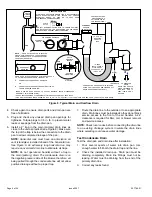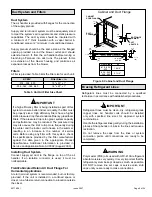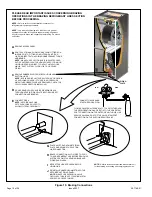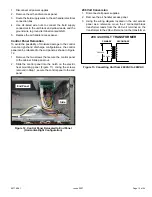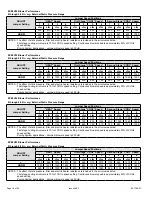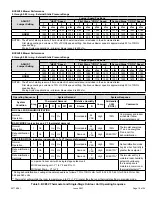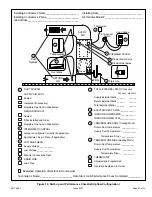
507789-01
Issue 2007
Page 22 of 24
3.
Check the air flow from a register to confirm that the
system is moving cooled air.
4.
Set the thermostat 5ºF higher than the indoor
temperature. The indoor blower and outdoor unit
should cycle off.
Check Electric Heat (If Used)
1. Set thermostat to call for auxiliary heat (approximately
5°F above ambient temperature). The indoor blower
and auxiliary heat should come on together. Allow a
minimum of 3 minutes for all sequencers to cycle on.
2. Set the thermostat so that it does not call for heat.
Allow up to 5 minutes for all sequencers to cycle off.
Professional Maintenance
Failure to follow instructions will cause damage to the
unit.
This unit is equipped with an aluminum Omniguard
TM
coil. Aluminum coils may be damaged by exposure to
solutions with a pH below 5 or above 9. The aluminum
coil should be cleaned using potable water at a
moderate pressure (less than 50psi). If the coil cannot
be cleaned using water alone, it is recommended to use
a coil cleaner with a pH in the range of 5 to 9. The coil
must be rinsed thoroughly after cleaning.
In coastal areas, the coil should be cleaned with potable
water several times per year to avoid corrosive buildup
(salt).
NOTICE
Homeowner Maintenance
Do not operate system without a filter. A filter is required
to protect the coil, blower, and internal parts from
excessive dirt and dust. The filter is placed in the return
duct by the installer.
IMPORTANT
Inspect air filters at least once a month and replace or
clean as required. Dirty filters are the most common cause
of inadequate heating or cooling performance.
Replace disposable filters. Cleanable filters can be cleaned
by soaking in mild detergent and rinsing with cold water.
Install new/clean filters with the arrows on the side pointing
in the direction of air flow. Do not replace a cleanable (high
velocity) filter with a disposable (low velocity) filter unless
return air system is properly sized for it.
If water should start coming from the secondary drain
line, a problem exists which should be investigated and
corrected. Contact a qualified service technician.
Repairing or Replacing Cabinet Insulation
DAMAGED INSULATION MUST BE REPAIRED OR
REPLACED
before the unit is put back into operation.
Insulation loses its insulating value when wet, damaged,
separated or torn.
IMPORTANT
Matte- or foil-faced insulation is installed in indoor
equipment to provide a barrier between outside air
conditions (surrounding ambient temperature and humidity)
and the varying conditions inside the unit. If the insulation
barrier is damaged (wet, ripped, torn or separated from the
cabinet walls), the surrounding ambient air will affect the
inside surface temperature of the cabinet.
The temperature/humidity difference between the inside
and outside of the cabinet can cause condensation on the
inside or outside of the cabinet which leads to sheet metal
corrosion and, subsequently, component failure.
Repairing Damaged Insulation
Areas of condensation on the cabinet surface are an
indication that the insulation is in need of repair.
If the insulation in need of repair is otherwise in good
condition, the insulation should be cut in an X pattern,
peeled open, glued with an appropriate all-purpose glue
and placed back against the cabinet surface, being careful
to not overly compress the insulation so the insulation can
retain its original thickness. If such repair is not possible,
replace the insulation. If using foil-faced insulation, any
cut, tear, or separations in the insulation surface must be
taped with a similar foil-faced tape.
1. CUT INSULATION IN X PATTERN
2. APPLY GLUE
3. PRESS GLUED TABS AGAINST CABINET
GLUE - Make sure there is
full coverage of glue on the
metal or insulation so there
are no areas where air
pockets may form which
can lead to sweating.
Figure 17. Recommended Blower Speed Taps

